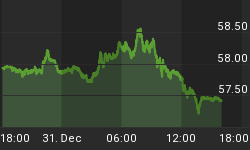In case you had not noticed, the price of crude oil has hit new all-time record highs in recent days (shown in the chart below). Yes, I know, in "real" terms, the price of crude is not at an all-time high. But relative to other prices, it still is a heck of a lot higher than it was a year ago. And that is what matters for the behavior of economic activity over the next several quarters. What effect on the economic growth, qualitatively speaking, can we expect from the rapid runup in energy prices in the past year and what should the Fed's response to this effect be?

Energy obviously is an important input for the production of a wide spectrum of goods and services. Energy's recent price increase is indicative of an excess demand for it. Unlike the energy price spikes of 1973 and 1979, today's spike has resulted not from a shift back in the supply of energy. Just the opposite inasmuch as both OPEC and non-OPEC producers of crude are pumping like there is no tomorrow. Rather, today's runup in energy prices is the result of shift out in demand. But whether the increase in the price of energy has resulted from a shift back in supply or a shift out in demand is immaterial for the case at hand. Either way, the relative shortage of energy will be a constraint on economic growth. Without new energy-conserving production technologies, the global economy will not physically be able to grow as rapidly this year as it did last year because of the relative shortage of energy. So, all else the same, the rise in energy prices is going to lead to slower U.S. real economic growth in 2005.
How should the Fed respond to this coming slowdown in real GDP growth? Some mainstream economists suggest that the Fed should stop raising the funds rate because the rise in the price of energy is a substitute for a more restrictive monetary policy. Changes in monetary policy affect the aggregate demand for goods and services, not the aggregate supply. To understand this, consider a counterfeiter. When she exchanges her paper for goods and services, has she created anything but demand? She did not produce any good or service to "earn" the paper she is passing. The same is true for a central bank. It is nothing but a legal counterfeiter. So, to argue that higher energy prices are a substitute for a more restrictive monetary policy is to implicitly assume that higher energy prices also affect aggregate demand.
But they don't. When you fill up your Hummer's fuel tank, those increased dollars you are spending do not disappear. Some other entity receives them, then spends them on goods, services, salaries, stock dividends, stock buybacks, exports from the U.S., or lends dollars to those who will spend them. So, growth in aggregate demand does not slow down because of an increase in energy prices. Again, the slowdown in real economic activity occurs because of the physical constraint on production coming from the relative shortage of energy.
Suppose the unemployment rate dropped sharply and labor compensation spiked upward. These events would represent a relative shortage of labor. Just as energy is a key input for the production of a wide spectrum of goods and services, so, too, is labor. A relative shortage of labor would represent a physical constraint on economic growth. Would these same mainstream economists who argue for a cessation or a diminution of Fed interest rate hikes in the face of energy price increases make the same argument for labor "price" increases?
If a higher real fed funds rate were appropriate before this renewed rise in energy prices in order to slow down aggregate demand growth, it is even more appropriate now. Why? Because growth in aggregate supply will be slowing as a result of the energy shortage. To allow aggregate demand to keep growing in the face of slower growth in aggregate supply is a recipe for stagflation. That is exactly what some mainstream economists are implicitly advocating when they argue for a pause in Fed rate hikes because of energy price spikes.
















